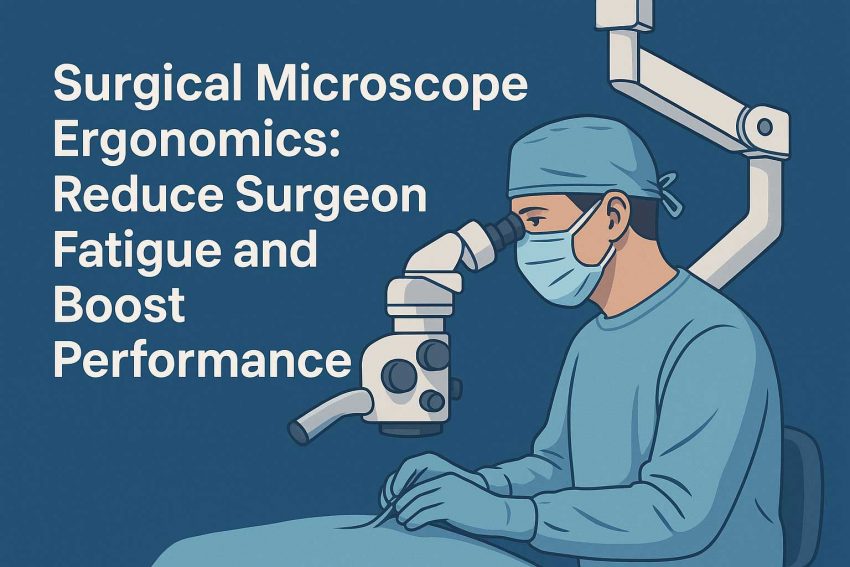Learn how surgical microscope ergonomics can help reduce surgeon fatigue, prevent musculoskeletal strain, and improve surgical outcomes. Ergonomic tips, features, and setup included
Discover how surgical microscope ergonomics can reduce surgeon fatigue, improve posture, and enhance surgical performance. Learn features, tips, and setup best practices
Introduction: Why Ergonomics Matter in Microsurgery
Surgeons often spend long hours in static positions, performing procedures that demand extreme precision. In such high-stakes environments, the ergonomics of a surgical microscope can significantly influence not just comfort, but surgical performance and long-term health.
Poor microscope setup contributes to neck strain, eye fatigue, lower back pain, and even repetitive stress injuries. On the other hand, a well-designed ergonomic system can enhance focus, extend a surgeon’s career, and improve patient outcomes.
What Is Surgical Microscope Ergonomics?
Surgical microscope ergonomics refers to the design and positioning of microscope components to promote natural posture, minimize strain, and support prolonged use. It includes adjustable viewing angles, proper seating, foot controls, and balanced positioning of microscope arms.
When done correctly, ergonomic positioning aligns the body, reduces muscle tension, and allows the surgeon to focus fully on the procedure rather than discomfort.
Common Ergonomic Problems Surgeons Face
- Neck and shoulder strain from poor eyepiece angle
- Slouched posture due to incorrect table height or arm position
- Eye fatigue from improperly aligned binoculars
- Repetitive strain from manual microscope adjustments
- Back pain from fixed, unsupported posture over long hours
Key Ergonomic Features to Look For
1. Adjustable Eyepieces and Binocular Tubes
Look for binoculars that tilt, swivel, and extend. This allows surgeons of different heights and preferences to maintain a neutral neck position without straining to look through the lenses.
2. Motorized Controls and Foot Pedals
Modern microscopes include foot-controlled focus, zoom, and positioning, allowing for hands-free operation and reducing repetitive hand movements.
3. Counterbalanced Suspension Arms
Counterweighted arms enable effortless repositioning without destabilizing the microscope. This minimizes unnecessary muscular strain during adjustments.
4. Ergonomic Seating and Table Height
An ergonomic setup includes an adjustable chair with lumbar support and a table height that prevents hunching or leaning forward.
5. Integrated Displays and Digital Viewing
Some systems offer HD monitors or 3D digital imaging so that the surgeon can look at a screen instead of being tied to eyepieces. This approach offers more freedom of posture.
Best Practices for Microscope Ergonomics in the OR
- Position your microscope so that your head stays upright and eyes look forward, not down.
- Adjust the working height of your chair, microscope, and surgical field so you don’t hunch or stretch.
- Keep elbows close to your body to reduce shoulder tension.
- Use a foot pedal instead of frequently reaching for knobs.
- Take micro-breaks every 30–45 minutes during lengthy surgeries.
Long-Term Benefits of Ergonomic Setup
- ✅ Decreased physical fatigue during surgery
- ✅ Reduced risk of long-term musculoskeletal disorders
- ✅ Improved concentration and mental stamina
- ✅ Enhanced accuracy and surgical control
- ✅ Longer career longevity for surgeons
Ergonomic Microscope Brands to Consider
| Brand | Notable Ergonomic Features |
|---|---|
| Zeiss | ErgoBinoculars, magnetic brakes, HD camera integration |
| Leica | Adjustable observer tubes, ergonomic handgrips, modular arms |
| Moeller | Multi-axis arms, tiltable tubes, lightweight design |
| Olympus | User-programmable foot pedals, high-resolution 3D displays |
Conclusion: Don’t Overlook Ergonomics in Microscope Selection
While optical performance often gets the spotlight, ergonomic design is equally vital in surgical microscopes. It’s not just about comfort — it’s about protecting the surgeon’s physical health, maintaining peak focus, and delivering top-tier surgical results.
For surgeons and healthcare facilities, investing in ergonomically advanced surgical microscopes is a strategic move toward long-term success.
